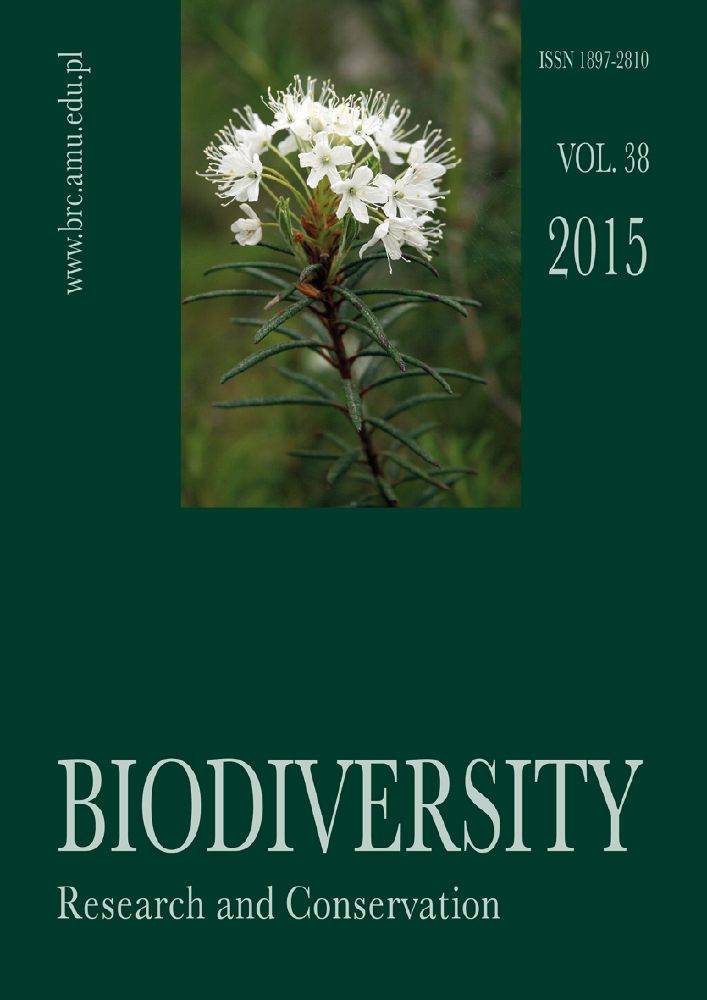Abstract
Natural water reservoirs are very valuable floristic sites in south-western Poland. Among them, the most important for the preservation of biodiversity of flora are oxbow lakes. The long-term process of human pressure on habitats of this type caused disturbances of their biological balance. Changes in the water regime, industrial development and chemisation of agriculture, especially in the period of the last two hundred years, led to systematic disappearances of localities of many plant species connected with rare habitats and also to the appearance of numerous invasive plant species. They are: Azolla filiculoides, Echinocystis lobata, Erechtites hieraciifolia, Impatiens glandulifera, I. parviflora, Reynoutria japonica, Solidago canadensis, S. gigantea and S. graminifolia. Field works were conducted in years 2005-2012.
References
Anioł-Kwiatkowska J., Berdowski W. & Wójcik G. 1992. Synantropizacja obszarów chronionych w Masywie Ślęży. Acta Univ. Wratisl. 1358 Pr. Bot. 48: 3-44.
Braun-Blanquet J. 1964. Pflanzensoziologie, Grundz ge der Vegetationskunde. 865 pp. Dritte Auflage. Springer Verlag, Wien-New York.
Burkart M. 2001. River corridor plants (Stromtalplanzen) in Central European lowland: a review of a poorly understood plant distribution pattern. Global Ecol. Biogeogr. 10: 449-468.
Dajdok Z., Anioł-Kwiatkowska J. & Kącki Z. 1998. Impatiens glandulifera Royle in the floodplain vegetation of the Odra river (West Poland). In: U. Starfinger, K. Edwards, I. Kowarik & M. William son (eds.). Plant invasions: ecological mechanisms and human respondes, pp. 161-168. Backhuys Publishers, Leiden, the Netherlands.
Dajdok Z., Anioł-Kwiatkowska J. & Kącki Z. 2003. Distribution of Impatiens glandulifera along the Odra river. In: A. Zając, M. Zając & B. Zemanek (eds.). Phytogeographical problems of synanthropic plants, pp. 125-130. Institute of Botany, Jagiellonian University, Cracow.
Dajdok Z. & Kącki Z. 2003. Kenophytes of the Odra riversides. In: A. Zając, M. Zając & B. Zemanek (eds.)., Phytogeographical problems of synanthropic plants, pp. 131-136. Institute of Botany, Jagiellonian University, Cracow.
Górski P., Czarna A. & Tokarska-Guzik B. 2003. Distribution of Erechtites hieracifolia (L.) Raf. ex DC. (Asteraceae) in Poland. In: A. Zając, M. Zając & B. Zema nek (eds.), Phytogeographical problems of synanthropic plants, pp. 147-1153. Institute of Botany Jagiellonian University, Cracow.
Horska-Schwarz S. 2006. Ewolucja starorzeczy jako przejaw starzenia się geokompleksów dolinnych w oparciu o powierzchnie testowe doliny Odry Oława - Wrocław. In: A. Richling, B. Stojek, M. Strzyż, I. Szumacher & A. Świercz (eds.), Regionalne studia ekologicznokrajobrazowe. Problemy ekologii krajobrazu 16(1): 161-169.
Matuszkiewicz W. 2005. Przewodnik do oznaczania zbiorowisk roślinnych Polski. In: J. B. Faliński (ed.). Vademecum Geobotanicum 3, 537 pp. Wyd. Nauk. PWN, Warszawa.
Mirek Z., Piękoś-Mirkowa H., Zając A. & Zając M. 2002. Flowering plants and pteridophytes of Poland. A checklist. In: Z. Mirek (ed.). Biodiversity of Poland, 1, 442 pp. W. Szafer Institute of Botany, Polish Academy of Sciences, Kraków.
Oberdorfer E. 1994. Pflanzensoziologische Exkursionsflora. 7 Aufl. 1050 pp. Verl. Eugen Ulmer, Stuttgart.
Olaczek R. 2000. Antropogeniczne czynniki przekształcenia dolin rzecznych. Rzeki 9: 119-142.
Ot’ahel’ová H.1995. Lemnetea. In: M. Valachovič (ed.), Rastlinné spoločenstwa Slovenska. 1. Pionierska vegetácia, pp. 131-150. Veda, Bratislava.
Passarge H. 1996. Pflanzengesellschaften Nordostdeutschlands. I. Hydro- und Therophytosa. 283 pp. J. Cramer, Berlin-Stuttgart.
Rosadziński S. 2008. Azolla w dolinie środkowej Odry. Bociek 94(2): 9-10.
Schube T. 1928. Ergebnisse der Durchforschung der schlesischen Gefässpflanzenwelt im Jahre 1927. Jahres- Bericht. Der Schles. Ges. Vaterl. Cultur. 80: 33-59.
Spałek K. 2003. Rare and endangered synanthropic plants of the Opole Plain (SW Poland). In: A. Zając, M. Zając & B. Zemanek (eds.), Phytogeographical problems of synanthropic plants, pp. 325-330. Institute of Botany, Jagiellonian University, Cracow.
Šumberová K. 2011. Vegetation of free floating aquatic plants. In: M. Chytrý (ed.), Vegetation of the Czech Republic. 3. Aquatic and Wetland Vegetation, pp. 43-99. Academia, Praha.
Szczęśniak E. 2009. Azolla paprotkowata (Azolla drobna) - Azolla filiculoides Lam. (Lamarck in Lamarck et al. 1783). In: Z. Dajd ok & P. Pawlac zyk (eds.), Inwazyjnegatunki roślin ekosystemów mokradłowych Polski, pp. 32-35. Wyd. Klubu Przyrodników, Świebodzin.
Szczęśniak E., Błachuta J., Krukowski M. & Picińska- Fałtynowicz J. 2009. Distribution of Azolla filiculoides Lam. (Azollaceae) in Poland. Acta Soc. Bot. Pol. 78(3): 241-246.
Tokarska-Guzik B. & Dajd ok Z. 2004. Rośliny obcego pochodzenia - udział i rola w szacie roślinnej Opolszczyzny. In: A. Nowak & K. Spałek (eds.), Ochrona szaty roślinnej Śląska Opolskiego, pp. 277-303. Uniwersytet Opolski, Opole.
Wołkowycki D. 1999. Azolla filiculoides (Pteridophyta, Azollaceae) w Polsce. Fragm. Flor. Geobot. Polonica 6: 165-170.




